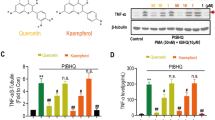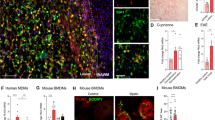Abstract
Kolaviron is a mixture of biflavonoids found in the nut of the West African edible seed Garcinia kola, and it has been reported to exhibit a wide range of pharmacological activities. In this study, we investigated the effects of kolaviron in neuroinflammation. The effects of kolaviron on the expression of nitric oxide/inducible nitric oxide synthase (iNOS), prostaglandin E2 (PGE2)/cyclooxygenase-2, cellular reactive oxygen species (ROS) and the pro-inflammatory cytokines were examined in lipopolysaccharide (LPS)-stimulated BV2 microglial cells. Molecular mechanisms of the effects of kolaviron on NF-κB and Nrf2/ARE signalling pathways were analysed by immunoblotting, binding assays and reporter assays. RNA interference was used to investigate the role of Nrf2 in the anti-inflammatory effect of kolaviron. Neuroprotective effect of kolaviron was assessed in a BV2 microglia/HT22 hippocampal neuron co-culture. Kolaviron inhibited the protein levels of NO/iNOS, PGE2/COX-2, cellular ROS and the pro-inflammatory cytokines (TNFα and IL-6) in LPS-stimulated microglia. Further mechanistic studies showed that kolaviron inhibited neuroinflammation by inhibiting IκB/NF-κB signalling pathway in LPS-activated BV2 microglia. Kolaviron produced antioxidant effect in BV2 microglia by increasing HO-1 via the Nrf2/antioxidant response element pathway. RNAi experiments revealed that Nrf2 is needed for the anti-inflammatory effects of kolaviron. Kolaviron protected HT22 neurons from neuroinflammation-induced toxicity. Kolaviron inhibits neuroinflammation through Nrf2-dependent mechanisms. This compound may therefore be beneficial in neuroinflammation-related neurodegenerative disorders.











Similar content being viewed by others
References
Polazzi E, Monti B (2010) Microglia and neuroprotection: from in vitro studies to therapeutic applications. Prog Neurobiol 92:293–315
Li W, Khor TO, Xu C, Shen G, Jeong WK, Yu S, Kong AN (2008) Activation of Nrf2-antioxidant signaling attenuates NFκB-inflammatory response and elicits apoptosis. Biochem Pharmacol 76:1485–1489
Koh K, Kim J, Jang YJ, Yoon K, Cha Y, Lee HJ, Kim J (2011) Transcription factor Nrf2 suppresses LPS-induced hyperactivation of BV-2 microglial cells. J Neuroimmunol 233:160–167
Sandberg M, Patil J, D’Angelo B, Weber SG, Mallard C (2014) Nrf2-regulation in brain health and disease: implication of cerebral inflammation. Neuropharmacology 79:298–306
Kim J, Cha YN, Surh YJ (2010) A protective role of nuclear factor-erythroid 2-related factor-2 (Nrf2) in inflammatory disorders. Mutat Res 690:12–23
Innamorato NG, Lasters-Becker I, Cuadrado A (2009) Role of microglial redox balance in modulation of neuroinflammation. Curr Opin Neurol 22:308–314
Innamorato NG, Rojo AI, García-Yagüe AJ, Yamamoto M, de Ceballos ML, Cuadrado A (2008) The transcription factor Nrf2 is a therapeutic target against brain inflammation. J Immunol 181:680–689
Farombi EO, Tahnteng JG, Agboola AO, Nwankwo JO, Emerole GO (2000) Chemoprevention of 2-acetylaminofluorene-induced hepatotoxicity and lipid peroxidation in rats by kolaviron-a Garcinia kola seed extract. Food Chem Toxicol 38:535–541
Farombi EO (2000) Mechanisms for the hepatoprotective action of kolaviron: studies on hepatic enzymes, microsomal lipids and lipid peroxidation in carbon tetrachloride-treated rats. Pharmacol Res 42:75–80
Nwankwo JO, Tahnteng JG, Emerole GO (2000) Inhibition of aflatoxin B1 genotoxicity in human liver-derived HepG2 cells by kolaviron biflavonoids and molecular mechanisms of action. Eur J Cancer Prev 9:351–361
Abarikwu SO, Farombi EO, Pant AB (2011) Biflavanone-kolaviron protects human dopaminergic SH-SY5Y cells against atrazine induced toxic insult. Toxicol In Vitro 25:848–858
Igado OO, Olopade JO, Adesida A, Aina OO, Farombi EO (2012) Morphological and biochemical investigation into the possible neuroprotective effects of kolaviron (Garcinia kola bioflavonoid) on the brains of rats exposed to vanadium. Drug Chem Toxicol 35:371–380
Olajide OJ, Enaibe BU, Bankole OO, Akinola OB, Laoye BJ, Ogundele OM (2015) Kolaviron was protective against sodium azide (NaN3) induced oxidative stress in the prefrontal cortex. Metab Brain Dis 31:25–35
Olaleye SB, Onasanwo SA, Ige AO, Wu KK, Cho CH (2010) Anti-inflammatory activities of a kolaviron-inhibition of nitric oxide, prostaglandin E2 and tumor necrosis factor-alpha production in activated macrophage-like cell line. Afr J Med Med Sci 39:41–46
Abarikwu SO (2014) Kolaviron, a natural flavonoid from the seeds of Garcinia kola, reduces LPS-induced inflammation in macrophages by combined inhibition of IL-6 secretion, and inflammatory transcription factors, ERK1/2, NF-κB, p38, Akt, p-c-JUN and JNK. Biochim Biophys Acta 1840:2373–2381
Farombi EO, Shrotriya S, Surh YJ (2009) Kolaviron inhibits dimethyl nitrosamine-induced liver injury by suppressing COX-2 and iNOS expression via NF-kappaB and AP-1. Life Sci 84(2009):149–155
Iwu MM (1985) Antihepatoxic constituents of Garcinia kola seeds. Experientia 41:699–700
Iwu MM, Igboko OA, Okunji CO, Tempesta MS (1990) Antidiabetic and aldose reductase activities of biflavanones of Garcinia kola. J Pharm Pharmacol 42:290–292
Okorji UP, Olajide OA (2014) A semi-synthetic derivative of artemisinin, artesunate inhibits prostaglandin E2 production in LPS/IFNγ-activated BV2 microglia. Bioorg Med Chem. 22:4726–4734
Fiebich BL, Akter S, Akundi RS (2014) The two-hit hypothesis for neuroinflammation: role of exogenous ATP in modulating inflammation in the brain. Front Cell Neurosci 8:260
Olajide OA, Kumar A, Velagapudi R, Okorji UP, Fiebich BL (2014) Punicalagin inhibits neuroinflammation in LPS-activated rat primary microglia. Mol Nutr Food Res 58:1843–1851
Dumont M, Beal MF (2011) Neuroprotective strategies involving ROS in Alzheimer disease. Free Radic Biol Med 51:1014–1026
Gao HM, Zhou H, Hong JS (2012) NADPH oxidases: novel therapeutic targets for neurodegenerative diseases. Trends Pharmacol Sci 33:295–303
Syapin PJ (2008) Regulation of haeme oxygenase-1 for treatment of neuroinflammation and brain disorders. Br J Pharmacol 155:623–640
Yuste JE, Tarragon E, Campuzano CM, Ros-Bernal F (2015) Implications of glial nitric oxide in neurodegenerative diseases. Front Cell Neurosci 9:322
Miyagishi H, Kosuge Y, Yoneoka Y, Ozone M, Endo M, Osada N, Ishige K, Kusama-Eguchi K, Ito Y (2013) Prostaglandin E2-induced cell death is mediated by activation of EP2 receptors in motor neuron-like NSC-34 cells. J Pharmacol Sci 121:347–350
Block ML, Hong JS (2005) Microglia and inflammation-mediated neurodegeneration: multiple triggers with a common mechanism. Prog Neurobiol 76:77–98
Abarikwu SO (2015) Anti-inflammatory effects of kolaviron modulate the expressions of inflammatory marker genes, inhibit transcription factors ERK1/2, p-JNK, NF-κB, and activate Akt expressions in the 93RS2 Sertoli cell lines. Mol Cell Biochem 401:197–208
Ratajczak-Wrona W, Jablonska E, Garley M, Jablonski J, Radziwon P, Iwaniuk A, Grubczak K (2014) PI3 K-Akt/PKB signaling pathway in neutrophils and mononuclear cells exposed to N-nitrosodimethylamine. J Immunotoxicol 11:231–237
Lee S, Suk K (2007) Heme oxygenase-1 mediates cytoprotective effects of immunostimulation in microglia. Biochem Pharmacol 74:723–729
Velagapudi R, Aderogba M, Olajide OA (2014) Tiliroside, a dietary glycosidic flavonoid, inhibits TRAF-6/NF-κB/p38-mediated neuroinflammation in activated BV2 microglia. Biochim Biophys Acta 1840:3311–3319
Foresti R, Bains SK, Pitchumony TS, de Castro Brás LE, Drago F, Dubois-Randé JL, Bucolo C, Motterlini R (2013) Small molecule activators of the Nrf2-HO-1 antioxidant axis modulate heme metabolism and inflammation in BV2 microglia cells. Pharmacol Res 76:132–148
Zujovic V, Taupin V (2003) Use of cocultured cell systems to elucidate chemokine-dependent neuronal/microglial interactions: control of microglial activation. Methods 29:345–350
Acknowledgments
The authors would like to thank the Physiological Society for funding this study, and for the award of an International Junior Research Grant (IJRG) to Dr Samuel A. Onasanwo.
Authors’ contributions
OAO designed the study and wrote the manuscript. SAO, RV, AE and OAO performed the experiments. OAO and RV analysed the data. All authors read and approved the final manuscript.
Author information
Authors and Affiliations
Corresponding author
Ethics declarations
Conflict of Interest
The authors declare that they have no competing interests.
Additional information
Samuel A. Onasanwo and Ravikanth Velagapudi have contributed equally to this work.
Rights and permissions
About this article
Cite this article
Onasanwo, S.A., Velagapudi, R., El-Bakoush, A. et al. Inhibition of neuroinflammation in BV2 microglia by the biflavonoid kolaviron is dependent on the Nrf2/ARE antioxidant protective mechanism. Mol Cell Biochem 414, 23–36 (2016). https://doi.org/10.1007/s11010-016-2655-8
Received:
Accepted:
Published:
Issue Date:
DOI: https://doi.org/10.1007/s11010-016-2655-8




